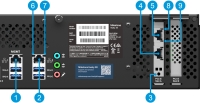Network interfaces
This section describes the network interfaces that you connect the different types of network traffic to. The network bandwidth requirements for the different types of traffic are usually not the same. The different types of network traffic are:
- Management
- Viewing
- Camera
- Storage
Connectors
The table below helps you choose the right network interface for the different types of network traffic. The LED status indicators can help check if the wanted network link speed is established.
| Connectors | Description |
|---|---|
| 1. LAN port 1 (1Gb/s) | Connect your local area network with internet connection, if available. This network is for management and viewing. |
| 2. LAN port 2 (1Gb/s) |
Connect your camera network. If your unit is equipped with a CNA card, connect your camera network to the LAN ports on the CNA card. |
| 3. PCI-E slot A | 2 x 10Gb/s CNA card (option) |
| 4. CNA card LAN port 2 (10Gb/s) |
Connect these types of networks to the CNA card LAN ports:
|
| 5. CNA card LAN port 1 (10Gb/s) |
| LED status indicators | LED colors | Description |
|---|---|---|
| 6. LAN ports activity | Flashing yellow | Actively transmitting or receiving packets |
| 7. LAN ports link speed |
Green Yellow Off |
1Gb/s 100Mb/s 10Mb/s |
| 8. CNA card LAN ports link speed | Green | 10Gb/s |
| Yellow | 1Gb/s or 100Mb/s | |
| 9. CNA card LAN ports activity |
Flashing green |
Actively transmitting or receiving packets |
Troubleshoot a network interface
- Check the status indicators on the LAN port connector:
- If the link speed indicator does not light up, check all cable connections
- If the activity indicator does not light up, the network driver files might be damaged or missing. Remove and reinstall the drivers if applicable. For more information, see the CNA cards documentation
- Use another connector on the switch or hub
- In Windows 10, go to Network status > Change adapter options to check that the LAN ports are enabled and connected.
- Make sure that the LAN ports and switches on the network are all set to the same data transmission speed and duplex. For more information, see the documentation for each network device.
-
Make sure that all network cables are of the proper type and that the cables do not exceed the maximum length.
If all troubleshooting fails, contact your Milestone reseller.


